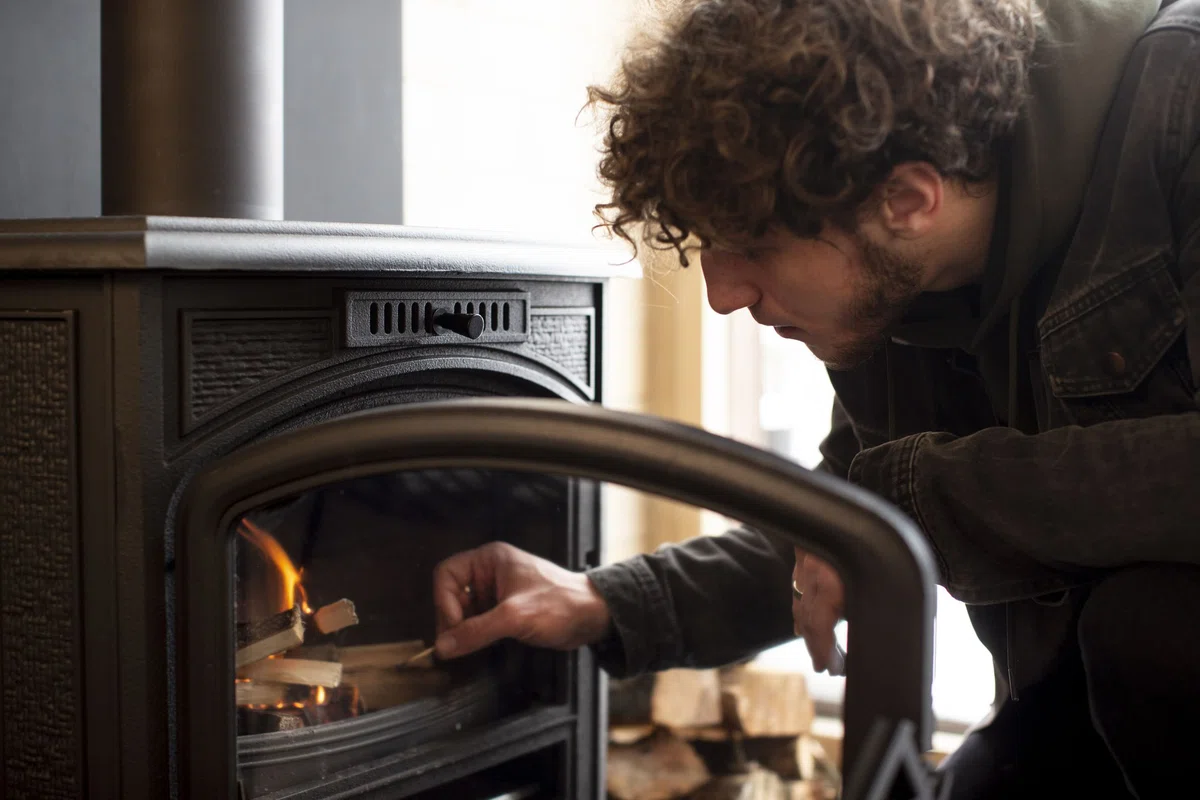
Stove selection and installation: comparison of metal and brick models
Comparative analysis of metal and brick ovens for the home. Learn about the benefits and features of each type, installation costs and site selection. Entrust the installation to professionals to ensure the safety and efficiency of the oven. Create comfort and coziness in your home with the perfect oven for you.
Content
- Metal stove
- Whether a special foundation is required for the installation of a metal furnace
- Where you should place your metal furnace
- Residential metal furnace purchase and installation costs
- Brick oven
- Foundations for a brick oven
- Which location should be chosen to install a brick oven
- The cost to purchase and install a brick oven in a residential property
- In addition to these costs for materials and labor, there are other costs to consider when installing a brick oven
- Frequently Asked Questions
1. What type of furnace is best to choose?
2. How to determine the labor cost of installing a new furnace?
3. How do I choose a contractor to install my furnace?
When it comes to installing a new furnace in your home, you are faced with two major questions: which model to choose and what is the cost of this procedure. In order to better understand this issue, we have conducted a comparative analysis of two popular types of modern stoves: metal and brick.
Unless you have experience with stoves, it is not recommended that you install the stove yourself. There are too many risks involved: improper installation of the chimney or incorrect positioning of the bricks can cause smoke to linger inside the house instead of escaping normally to the outside. A safer solution would be to contact qualified professionals.
Metal stove
Metal stove is an optimal choice for use at the dacha, where people live from spring to fall. Its peculiarity is that it has certain peculiarities in warming up the room, and does not always provide an even distribution of heat. However, thanks to its unique characteristics, the metal furnace successfully copes with harsh fall nights, when the air outside becomes cold and unfit for a comfortable stay.
The metal furnace we review is the result of modern technology and advanced engineering. It is made of strong and durable metal, which gives it stability and reliability in operation. Thanks to its construction and quality materials, this furnace ensures efficient fuel utilization, which is an important factor in saving resources and reducing costs.
In addition to its practical properties, the metal stove also contributes to the aesthetic component of the dacha interior. Its elegant and modern design harmoniously complements the overall style of the room, creating an atmosphere of coziness and comfort. Opportunities to choose a suitable version of the metal stove today is plenty: different shapes, sizes and colors allow you to choose a model that perfectly meets the individual preferences and needs of each dacha owner.
However, when choosing a metal stove for dacha, it is necessary to take into account some additional factors. First, it is important to pay attention to the insulating properties of the stove to minimize heat loss and ensure maximum efficiency. You should also take into account the size of the room and its features to choose a furnace of optimal power and able to evenly heat the entire room.
Modern metal stoves have a variety of functions and features that make them even more attractive for use in the countryside. Some models are equipped with automatic temperature control systems, which provides comfort and convenience in use. There are also stoves that can operate on different types of fuel, which can be useful in conditions of limited access to certain types of energy resources.
Whether a special foundation is required for the installation of a metal furnace
On average, the weight of a metal stove usually does not exceed 400 kg, while small bourgeois stoves usually weigh no more than 80 kg. Often, the advantage of such designs is their relative lightness, which makes them more mobile and convenient to use. Despite this, however, it is worth noting that foundation installation is often recommended for the reliable and safe operation of a metal stove.
The foundation plays an important role in the stability and reliability of the furnace. It is able to distribute the weight of the furnace evenly over the entire area of its foundation, which helps prevent possible deformations or shifts as the metal heats and cools. Thanks to the foundation, the metal furnace can remain stationary and stable even under significant thermal loads.
The foundation also helps to reduce vibrations and noise that may occur during the operation of the furnace. It serves as a kind of shock absorber, absorbing vibrations caused by the movement of parts and forces acting inside the furnace chamber. Thus, the installation of the foundation contributes to a more comfortable and safer working environment.
In addition to providing stability and reducing vibrations, the foundation also helps to improve the efficiency of the kiln. With a properly designed and installed foundation, heat loss is minimized and the energy efficiency of the system is improved. This is especially important in the case of metal furnaces, where efficient heat distribution ensures optimal heating temperatures and more economical fuel utilization.
Where you should place your metal furnace
There are several important aspects to consider when choosing where to place a metal stove in a room. As mentioned earlier, drafts affect the efficiency of the furnace, so it is recommended to choose a location where they can be minimized or completely eliminated. In this way, the furnace will optimally heat the house, providing comfort and warmth.
- In addition to distances, the size of the room itself, in which the stove will be placed, plays a significant role. It is recommended that the room area should be at least 16 m2. This will ensure proper heat distribution and avoid overheating of the room.
It is important to note that the metal oven must be installed on a solid and indestructible surface. A suitable option may be a specially designed stove slab or a reinforced concrete floor. Such a base will ensure the stability and safety of the operation of the furnace.
In addition, when choosing a place to place the metal stove, you should pay attention to the presence of convenient access to the chimney in the room. The presence of a vertical chimney, passing through the highest point of the room and sufficiently removed from windows and doors, contributes to the effective removal of smoke.
An interesting solution may also be the use of special heat-reflecting screens or insulating materials near the walls, which will help retain heat in the room and provide more efficient heating.
When choosing the best place to place a metal furnace, it is important to take into account the individual characteristics of the room and provide the best conditions for its performance. Following the location, ventilation and safety recommendations will maximize the efficiency and longevity of the furnace and create a comfortable atmosphere in the home.
Residential metal furnace purchase and installation costs
Buying and installing a metal furnace are important aspects when it comes to heating your home. Let's look at the different factors that affect the cost of this process and determine the best options for you.
When choosing a metal furnace for your home, one of the main factors that affect the cost is the type and size of the furnace. There are a variety of options on the market, and each one has its own features and cost.
Starter models of metal stoves are usually available for around 220 Georgian Lari, and they are suitable for heating a room of up to 30 square meters. If you require something more stylish and aesthetically pleasing, like a fireplace, you should consider more expensive options, which can cost around 630, 950, 50,000 or even 1600 Georgian Lari.
Aside from the style, the cost also depends on the materials used in making the stove. You can choose a metal furnace made from a variety of materials including cast iron, steel, and other alloys. Each material has its own benefits and costs, so it's important to carefully consider all of your options before making a decision.
In addition to the cost of the furnace itself, you should consider the additional cost of the chimney and the handyman's fee to install the furnace in your home.
The chimney is an integral part of the furnace and is necessary for the safe output of smoke. The price of a chimney depends on several factors, including the number of parts and the materials used. Chimney kit options can range in price from 315 to 2850 Georgia Lary. It is recommended to purchase the chimney along with the stove from the same manufacturer to ensure compatibility and efficiency of the system.
You also need to take into account the cost of the handyman. The cost of installing a stove in the dacha depends on the region and the complexity of the work. It is advisable to contact a professional handyman with experience in metal furnace installation to ensure a quality and safe installation.
If you find that the cost of purchasing and installing a metal stove is beyond your budget, there are alternatives that you can consider.
One option is the use of portable metal furnaces. These can be more affordable and require less installation costs. However, keep in mind that these furnaces typically provide heat to a limited area and may be less efficient compared to installing a fixed furnace.
You can also consider installing a central heating system. While such a system requires a significant investment in the beginning, it can be more efficient and cost-effective in the long run.
When buying and installing a metal furnace in your home, it is important to consider all the factors that affect the cost. Choosing the right furnace, chimney and professional handyman will ensure efficient and safe heating in your home. Consider all options and alternatives to choose the best option that fits your needs and budget.
Brick oven
Brick stoves are installed in permanent residences or summer houses that are visited throughout the year. These unique stoves require at least 2-3 hours of heating, but in return they provide heat for 12 hours or more. They are renowned for their reliability and efficiency, providing comfort and delighting owners with their superior features.
High quality materials such as fireproof bricks and special fireproof mortars are used in the construction of a brick oven. Bricks of different shapes and sizes are carefully laid in a specific order using professional methods. This ensures that the structure is strong and durable, allowing the kiln to store and release heat efficiently.
Brick stoves are a great source of heat and create a special atmosphere in the home. Their unique design and aesthetics add charm and character to the interior. Due to the variety of shapes and styles, each kiln can be individually designed and customized to meet the special needs of the owner.
An important advantage of brick ovens is their ability to retain heat for a long time. Through the use of high quality materials and special construction, kilns retain heated walls and mass that gradually release heat into the room. This unique heat storage effect ensures a comfortable temperature for hours after the furnace has finished firing.
In addition to their excellent heat output, brick furnaces also efficiently distribute heat throughout the room. Their design and unique flue gas path allow for even distribution of heat energy, heating every corner of the room. This is especially useful during the cold winter months when constant and even heating is desirable.
The importance of proper brick furnace maintenance should not be overlooked. Regular cleaning and strength checks will help keep it in top condition. In addition, the use of quality fuel and proper firing techniques will play a key role in ensuring that your kiln performs optimally.
Foundations for a brick oven
There are various factors to consider when discussing a foundation for a brick kiln. One of the main aspects is the weight of the kiln itself, which influences the choice of the best type of foundation. Let's look at this issue in more detail.
If the weight of the brick oven does not exceed 450 kg, you can do without a concrete pad for its installation. The concrete pad is the base on which the oven is installed. However, if the weight of the oven exceeds the 450 kg mark, a more solid and reliable foundation is required.
For furnaces that weigh between 450 kg and 750 kg, a full foundation is recommended. This is especially important because such stoves have a significant weight and require a strong support. Such a foundation should be designed and constructed while the main foundation of the house is being laid.
When creating a foundation for a brick kiln, it is important to consider not only the weight of the kiln itself, but also some other aspects. For example, the total load that the foundation will support and the soil conditions at the construction site. A quality foundation ensures the stability and longevity of the kiln, and prevents possible future problems with settling or warping.
There are several types of foundations that can be used for brick kilns. One common option is a strip foundation. It is a strip of reinforced concrete building material that covers the perimeter of the future kiln. The strip foundation guarantees an even distribution of the load and ensures the stability of the oven.
Another option is a pile foundation. It involves the use of piles that are installed in the ground to a sufficient depth to ensure the stability of the furnace. The pile foundation is a reliable solution, especially if the soil on the site has a low bearing capacity.
You should also pay attention to the peculiarities of installing the foundation for a brick oven. It is important to position the foundation correctly, taking into account the geometric dimensions of the oven and its future position in the room. It is recommended to consult with professionals in order to get competent recommendations and realize a quality installation of the foundation.
Which location should be chosen to install a brick oven
A brick heating oven is embedded in a wall, extending its heat to several adjoining rooms. By placing a brick oven with a cooking surface between the kitchen and the main room of the house, you can not only provide heat, but also create space for cooking.
When choosing a place to install a brick oven, it is important to consider that just as with a metal oven, it should be placed at a certain distance from the walls. It is recommended to leave a gap between the back of the oven and the wall between 110 and 125 centimeters.
However, along with these generally accepted rules, there are other possibilities for the location of the brick oven that can be interesting and practical. Here are a few options to consider when planning a brick oven installation:
- Central location: Placing the brick oven in the center of the room creates a focused heat effect, distributing heat evenly in all directions. This configuration provides a comfortable temperature in all corners of the room and also creates an aesthetically pleasing accent.
- Niche or Arch: Instead of placing a brick kiln on a straight wall, you can create a niche or archway for its installation. This will not only add an interesting architectural element to the interior, but will also help in integrating the kiln with its surroundings.
- Partition: A brick stove can also be placed as a partition between two rooms. This arrangement will not only provide warmth to both rooms, but will also create a functional and visually appealing space planning solution.
- Corner layout: Placing a brick kiln in the corner of a room will help to make the best use of the space and give it a special charm. This arrangement can be particularly useful in small rooms where every square meter counts.
It should be noted that when choosing where to install a brick oven, you should consider not only its efficiency in distributing heat, but also its compliance with safety and building code requirements. Consultation with a qualified professional will help you choose the most suitable option for your home and ensure comfortable and safe use of the brick oven.
The cost to purchase and install a brick oven in a residential property
Installing a brick furnace in your Georgia home is an important part of construction that requires careful consideration of various factors that may affect the cost of the process. One of the key factors that determine the final price is the choice of brick that will be used in the construction of the furnace.
Georgia furnace builders usually prefer to use ceramic bricks, which ensure the reliability and longevity of the furnace. However, in some cases, they may use fire bricks to clad the kiln or other elements of the kiln. This choice of material can affect the overall cost, as refractory bricks are usually more expensive.
However, in addition to brick selection, the cost of installing a brick furnace in your Georgia home is also dependent on the size of the furnace. The larger the furnace, the higher the cost. This is because building a larger furnace requires more materials and time to build.
Let's imagine a situation where you need to install a brick oven that can heat a 50 square meter summer house. There are several factors to consider when calculating the total cost of furnace installation:
- Bricks: approximately 1,000 bricks will be needed to build the stove itself, the lining, the chimney and the fire screen. One of the common types of bricks in Georgia is Vitebsk red brick, which costs about 0.8 Georgian lari per piece. Thus, it will cost about 790 Georgian lari for a brick.
- Stove mix: for proper installation of the stove, you will need stove mix, which costs about 315 Georgian GEL.
- Stove molding: additionally, you will need stove molding, which will cost about 790 Georgian GEL.
- Thermal insulation: to ensure good thermal insulation of the stove, an average amount of 220 Georgian GEL will be required.
Thus, the total cost of all consumables including delivery will be about 2520 Georgian lari.
However, in addition to the cost of materials, you should also take into account the cost of the craftsman's work. Usually laying one brick costs from 4 to 5 Georgian GEL, and the master usually charges about 4000 Georgian GEL for the work. This price includes the preliminary visit of the specialist, calculation and roofing works.
It is important to note that the price for a handyman can vary depending on the complexity of the task. For example, if the furnace needs to be installed on a complex roof, the craftsmen may increase the price for their services.
It is interesting to note that when installing a brick furnace in your Georgia home, it is possible to add extra features and functions that can enhance the comfort and efficiency of your furnace. For example, installing a furnace water pipe to heat water or utilizing an automatic temperature control system. However, these additional features can affect the overall cost of furnace installation and should be considered when planning the process.
In addition to these costs for materials and labor, there are other costs to consider when installing a brick oven
When installing a brick kiln, there may be additional costs associated with various aspects to consider. One important aspect is fire safety. Even if the required distance between the metal or brick wall and other surfaces in the house is met, the craftsman may recommend taking additional measures to ensure safety. Let's look at a few possible additional costs that may be incurred when installing a brick oven.
- Reinforced fire protection treatment of wooden surfaces: if wooden surfaces are close to the stove, additional treatment may be required to prevent fire. Special fire retardant impregnations or mastics should be purchased for this purpose. Additional costs for such materials should be considered when planning the installation of a brick oven.
- Wall cladding: to ensure safety and aesthetic appearance, the craftsman can offer wall cladding that will further protect surrounding surfaces from the negative effects of heat and fire. Cladding options may include the use of brick or basalt sheeting, and a stainless steel screen can be installed on top. The cost of a basalt sheet measuring 1,200 × 500 × 5 mm averages 12 Georgian GEL and a stainless steel screen measuring 1 meter by 1 meter costs about 158 Georgian GEL.
- Pre-flue sheet: Before installing a stove, a pre-flue sheet is usually laid to help prevent heating of neighboring surfaces and ensure safety. Such a sheet can be made of asbestos cardboard and covered with a steel sheet at least 1mm thick. There are also ready-made "fireplace mats" that can be installed in place of individual sheets. For example, a 400 × 600 mm model can cost about 48 Georgian lari.
These are just some of the possible additional costs that may be incurred when installing a brick furnace. It is important to contact an experienced craftsman who will be able to assess your specific requirements and suggest the best options to ensure the safety and efficiency of the oven. In addition to this, it is also worth considering the possible costs of additional equipment, installation materials and furnace hardware.
Frequently Asked Questions
❓ What is the best type of furnace to choose?
💡 Choosing the type of stove depends on your needs and preferences. You can choose a wood stove for traditional charm, or a gas or electric stove for convenience and energy efficiency.
❓ How do I determine the cost of installing a new furnace?
💡 The cost of installing a new furnace depends on several factors such as the type of furnace, materials, complexity of installation and labor hours. It is advisable to contact professionals who can give you an initial estimate of the cost based on your requirements.
❓How to choose a contractor for furnace installation?
💡 When choosing a contractor for furnace installation, it is advisable to look at their experience, reputation and licensing. Check out customer reviews and ask for bids from several professionals for comparison. Don't forget to also ask about warranty terms and time frame for the work.







4 comments
Log in to leave a comment